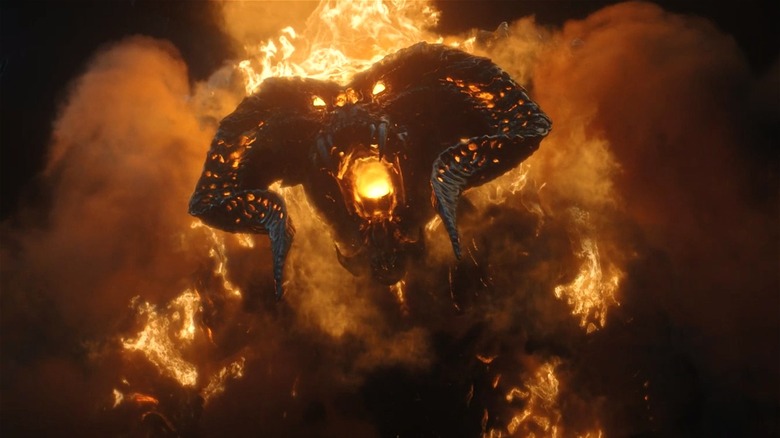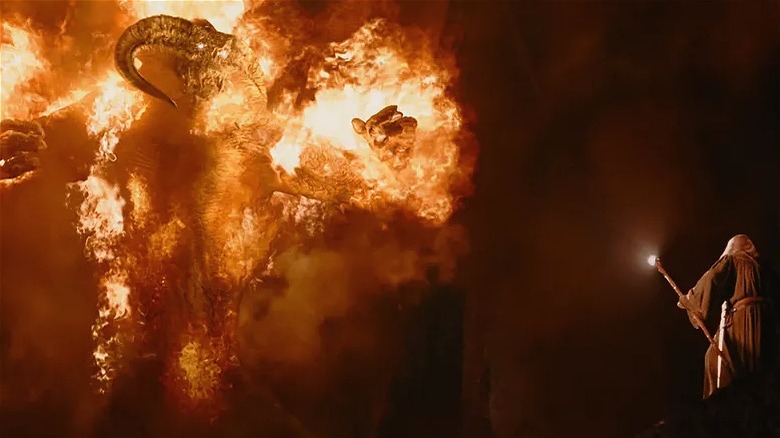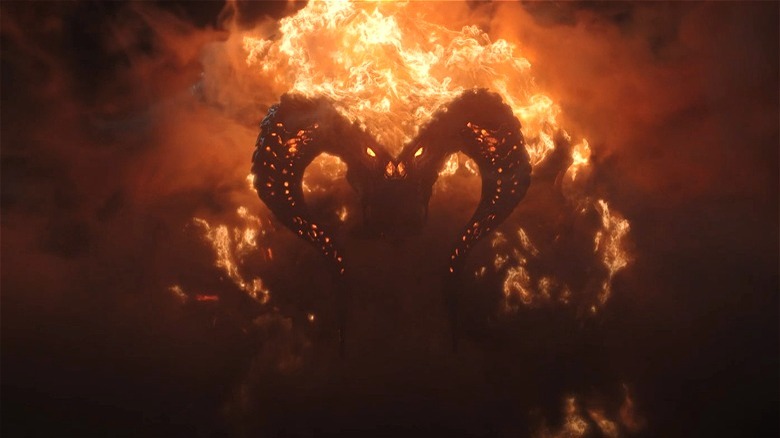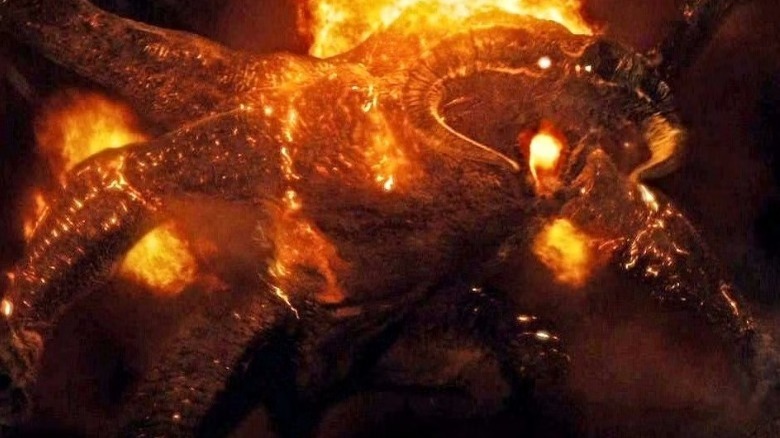Fly You Fools: The Lord Of The Rings' Balrog Explained
This post contains spoilers for episode 7 of "The Lord of the Rings: The Rings of Power."
In Peter Jackson's "The Fellowship of the Ring," the titular fellowship faces an ancient demonic threat in the mines of Moria. When surrounded by countless orcs inside the mines, a huge, demon-like fiery creature pursues the group to the bridge of Khazad-dûm, where Gandalf (Sir Ian McKellen) fights the creature. Right at the brink of victory, Gandalf is overwhelmed by the power of the creature, and shouts "Fly, you fools!" at his grief-stricken companions, as he falls into the depths of the Misty Mountains along with the demon.
As explained by Gandalf prior to the fight, this gigantic flaming beast is none other than a Balrog, who was inadvertently awakened by the dwarves while excavating too deep into the mines of Moria. Prime Video's "The Rings of Power" offers us a glimpse of this beast, who is seemingly awakened in the depths of the mines after the healed leaf of Lindon incinerates in front of the monster. This is obviously a prelude to what's about to occur, primarily the downfall of the dwarves and the fall of the mighty Khazad-dûm.
But, what exactly is a Balrog, and what role does this creature play in the fraught history of Middle-earth through the ages? Let's find out.
The creature's origins and evolution through the ages
Also known as Valaraukar, which means "demon of power" in Quenya, Balrogs are Maiar, beings as old as time, who were sent by the Valar to shape the world. In the wake of Morgoth/Melkor's rise to power, the Balrogs were seduced by his evil scheme and became corrupted in the process. After Melkor destroyed the Two Trees of Valinor (which were symbols of light and purity for the Valar), he roused the Balrogs to attack Ungoliant, his ally-turned-nemesis. As the Balrogs were already in Melkor's service, they diligently did his bidding.
Balrogs have been in combat with various characters in J.R.R. Tolkien's mythos over the First and Second Ages in Middle-earth. A key example is the Ñoldorin Elf, Fëanor, who was mortally wounded by Gothmog, the king of Balrogs at the time. This precipitated a rivalry between the elves and the Balrogs, and the latter attacked Elvish fortresses with the intent of killing them and their allies.
"The Rings of Power" touches upon the bittersweet victory of the War of Wrath, and as per Tolkien's lore, the Balrogs fought in the war but were mostly slain. The remaining beasts sought shelter in deep caverns and mines and were mostly dormant during the Second Age. However, the show seems to be hinting at a slight alteration in canon, as the Balrog in Durin's mine seems to be active. Although the mines are sealed at the moment, we know that they will be opened up for mithril mining pretty soon.
Is the show's awakened Balrog Durin's Bane?
Per "The Fellowship of the Ring," the dwarves were driven out of their home after they awakened a Balrog in TA 1980, who ended up killing King Durin VI. This led to the creature being dubbed "Durin's Bane," as it symbolized the downfall of what was once a powerful, prosperous dwarven rule. Thanks to our knowledge of what's about to happen, we know that Durin's Bane will be slain by Gandalf, who will be sent back to the Valar, triggering his transformation into the wiser, mightier Gandalf the White.
If we work out the probable chronology of events, it does seem that the Balrog that makes an appearance in the latest episode is none other than Durin's Bane. Although Tolkien dictates that Durin's Bane awakened sometime during the Third Age, "The Rings of Power" could somehow retrofit this to shape key events during the Second Age. It is unclear as to how things will take shape in that direction, but it is possible that the Balrog's (premature) presence could add layers of tragedy to the fall of Khazad-dûm. Within the context of the show, it does seem like the Balrog shall pass.
Balrogs are somewhat of a cultural icon
There are some inconsistencies in Tolkien's writings about Balrogs, as he often made revisions to origin stories or altered historical accounts to bring narrative threads together. In the initial mentions of these creatures, Tolkien described them as countless in number, although he later mentioned that there were no more than seven Balrogs. Interestingly, although Balrogs play a brief yet key role in Middle-earth's history, the creatures have inspired several video game creature designs over the years:
-
Creatures identical to Balrogs in appearance and characteristics can be seen in "Wartune" and "Dungeon Hunter: Alliance." Apart from a few variant features, these beasts were clearly inspired by Tolkien's work.
-
The Balor from "Dungeons & Dragons" is a clear homage to Balrogs, as earlier renditions of the game dubbed it as The Balrog, which was then changed due to copyright claims.
-
There's a boxer named Balrog in "Street Fighter II!"
-
The anime series Saint Seiya has a character named Balrog Rune, who is a servant of Hades, the ruler of the underworld.
-
Balrog is the name of a classic weapon in "Devil May Cry 5."
Balrogs are clearly influential in popular culture, and the creature's appearance in "Rings of Power" might lead to a Balrog renaissance. At least, that's what I'm hoping for.
"The Lord of the Rings: The Rings of Power" drops a new episode every Friday on Prime Video.



